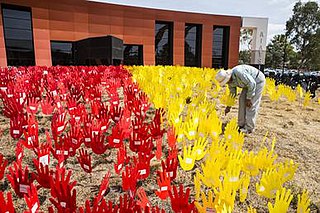
Victoria Square, also known as Tarntanyangga, is the central square of five public squares in the Adelaide city centre, South Australia.
NAIDOC Week is an Australian observance lasting from the first Sunday in July until the following Sunday. The acronym NAIDOC stands for National Aborigines' and Islanders' Day Observance Committee. NAIDOC Week has its roots in the 1938 Day of Mourning, becoming a week-long event in 1975.

The Australian Institute of Aboriginal and Torres Strait Islander Studies (AIATSIS), established as the Australian Institute of Aboriginal Studies (AIAS) in 1964, is an independent Australian Government statutory authority. It is a collecting, publishing, and research institute and is considered to be Australia's premier resource for information about the cultures and societies of Aboriginal and Torres Strait Islander peoples.

The South Australian Museum is a natural history museum and research institution in Adelaide, South Australia, founded in 1856 and owned by the Government of South Australia. It occupies a complex of buildings on North Terrace in the cultural precinct of the Adelaide Parklands. Plans are under way to move much of its Australian Aboriginal cultural collection, into a new National Gallery for Aboriginal Art and Cultures.
Kaurna is a Pama-Nyungan language historically spoken by the Kaurna peoples of the Adelaide Plains of South Australia. The Kaurna peoples are made up of various tribal clan groups, each with their own parnkarra district of land and local dialect. These dialects were historically spoken in the area bounded by Crystal Brook and Clare in the north, Cape Jervis in the south, and just over the Mount Lofty Ranges. Kaurna ceased to be spoken on an everyday basis in the 19th century and the last known native speaker, Ivaritji, died in 1929. Language revival efforts began in the 1980s, with the language now frequently used for ceremonial purposes, such as dual naming and welcome to country ceremonies.
Stephen George Page is an Australian choreographer, film director and former dancer. He is the former artistic director of the Bangarra Dance Theatre, an Indigenous Australian dance company. Page is descended from the Nunukul people and the Munaldjali of the Yugambeh people from southeast Queensland, Australia.
Kathleen Petyarre was an Australian Aboriginal artist. Her art refers directly to her country and her Dreamings. Petyarre's paintings have occasionally been compared to the works of American Abstract Expressionists Jackson Pollock and Mark Rothko, and even to those of J. M. W. Turner. She has won several awards and is considered one of the "most collectable artists in Australia". Her works are in great demand at auctions. Petyarre died on 24 November 2018, in Alice Springs, Australia.
Cairns Indigenous Art Fair is an arts and cultural event in the northern Australian city of Cairns, that showcases art by Contemporary Indigenous Australian artists. Established in 2009, the art fair is the opening event of the Cairns Festival.

Lewis William Arthur O'Brien, known as Yarlupurka, usually known as Uncle Lewis O'Brien, is an Aboriginal Australian elder of the Kaurna people.
Tarnanthi is a Festival of Contemporary Aboriginal and Torres Strait Islander Art held in Adelaide, South Australia, annually. Presented by the Art Gallery of South Australia (AGSA) in association with the South Australian Government and BHP. It is curated by Nici Cumpston.
Yvonne Koolmatrie is an Australian artist and weaver of the Ngarrindjeri people, working in South Australia.
Sally M. Nangala Mulda is an Arrernte and Southern Luritja artist who lives and works in Alice Springs. She paints for Tangentyere Artists.
Nici Cumpston, is an Australian photographer, painter, curator, writer, and educator.
The artist known as r e a is an Aboriginal Australian artist, also known as r e a Saunders, sometimes written Rea Saunders. As of 2019 r e a is a lecturer within the Aboriginal & Torres Strait Islander Unit at the University of Queensland.
Yhonnie Scarce is an Australian glass artist whose work is held in major Australian galleries. She is a descendant of the Kokatha and Nukunu people of South Australia, and her art is informed by the effects of colonisation on Indigenous Australia, in particular Aboriginal South Australians. She has been active as an artist since completing her first degree in 2003, and teaches at the Centre of Visual Art in the Victorian College of the Arts in Melbourne.
Narputta Nangala Jugadai (1933–2010) was an Aboriginal Australian artist born at Karrkurutinytja, who later lived at Haasts Bluff (Ikuntji) in the Northern Territory. Her language group was Pintupi/Pitjantjatjara, and her Dreaming was "Snake", "Jangala, Two Men" and "Two Women". She was a senior artist in her community at Ikuntji and prominent among the Ikuntji Women's Centre painters. She was the wife of the painter, Timmy Tjungurrayi Jugadai, and mother of Daisy Jugadai Napaltjarri and Molly Jugadai Napaltjarri.
Dem Mob, stylised as DEM MOB, is an Aboriginal hip hop group from the APY lands in northern South Australia, the first to rap in the Pitjantjatjara language.
Betty Muffler is an Aboriginal Australian artist and ngangkari (healer). She is a senior artist at Iwantja Arts, in Indulkana in Aṉangu Pitjantjatjara Yankunytjatjara, South Australia, known for a series of works on large linen canvases called Ngangkari Ngura .
Gail Mabo is an Australian visual artist who has had her work exhibited across Australia. She is the daughter of land rights campaigner Eddie Mabo and educator and activist Bonita Mabo. She was formerly a dancer and choreographer.
Vincent Warrior Copley was an Aboriginal Australian sportsman, activist, elder, and leader.




